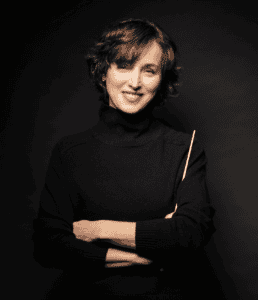October 20, 2024 / 2:30 p.m.
Immerse yourself in the magic of Mozart as Tania Miller conducts Sara Davis Buechner in one of his beloved piano concertos.
Listen on Spotify
Program
SHOSTAKOVICH
Chamber Symphony Op.110a
I. Largo
II. Allegro molto
III. Allegretto
IV. Largo
V. Largo
VALENTIN SILVESTROV
The Messenger
MOZART
Piano Concerto KV 503 No.25 in C
I. Allegro Maestoso
II. Andante
III. Allegretto
Program Notes
Chamber Symphony Op.110a
DMITRI SHOSTAKOVICH
Born: September 25, 1906, St. Petersburg, Russian Empire
Died: August 9, 1975, Moscow, Soviet Union
Composed: String Quartet, July 12-14, 1960, Chamber Symphony arranged 1967 Quartet
Premiered: October 2, 1960, Leningrad, Russia
Duration: 23 minutes
Contrary to what one may think, this work is not an original composition but an adaptation of Shostakovich’s String Quartet No. 8, Op.110. After the quartet’s premiere, and with Shostakovich’s permission, Rudolf Barshai, conductor of the Moscow Chamber Orchestra, received a commission to adapt the work for string orchestra. Skeptical, Shostakovich ultimately approved the orchestration, stating, “Sounds better than the quartet in the original! We will give the work a new name – Chamber Symphony Opus 110a.” Barshai went on to orchestrate four more of Shostakovich’s quartets, and in gratitude, Shostakovich dedicated his Symphony No. 14 to Barshai and the Moscow Chamber Orchestra.
The original String Quartet No. 8 was composed in 1960 during Dmitri Shostakovich’s stay in Dresden, Germany, where he was to work on music for Lev Arnshtam’s film Five Days, Five Nights. Profoundly affected by the destruction of Dresden following the Second World War and the oppressive atmosphere under Joseph Stalin’s regime, Shostakovich composed the Quartet in just three days instead of the film score. The dedication reads, “In memory of the victims of fascism and war.”
As one may guess by the dedication, Shostakovich often used his music to convey deeper meanings. In a letter to Isaac Glikman, he explained that this work also served as a personal requiem, “I thought that if I died suddenly, hardly anyone would write and dedicate a work to my memory. So, I decided to do something similar myself.” Shostakovich reflects the memories of this terror and fear under Stalin within the music itself. In the fourth movement, the repeated figure of three staccato bursts from the strings is believed by many to symbolize the dreaded foreign intelligence and domestic security agency of the Soviet Union (KGB) knocking on doors in the middle of the night to forcefully whisk people away to an unknown fate.
The Messenger
VALENTIN SILVESTROV
Born: September 30, 1937 Kyiv, Ukraine SSR (then Soviet Union)
Composed: 1996
Premiered: 1998, Kiev Kamerata, Kiev, Ukraine
Duration: 10 minutes
Ukrainian composer, Valentin Silvestrov, wrote The Messenger in 1996 after the sudden death of his wife Larysa Bondarenko, who was a musicologist.
The title of the piece is taken from the writings of the existential philosopher Yakov Druskin, a scholar from St. Petersburg. Druskin’s ‘messenger’ is a fictional character who represents a link between this world and the world beyond. This figure is shown in the score by a series of smooth, remote-sounding, Mozartian phrases, marked “as if enveloped in mist.”
Silvestrov said, “It is as if a visitor from some other dimension in time came to us with a message…perhaps Larysa herself, perhaps some distant muse speaking in the language of the late eighteenth century. This archaic and yet vitally contemporary language is filtered through a profoundly postmodern sensibility.”
The Messenger is scored for piano, string orchestra and a synthesizer. This last instrument is used to represent the gentle sighing of the wind that marks both the arrival and the departure of the messenger.
– Valentin Silvestrov, 2024
Mozart’s Piano Concerto KV 503 No. 25 in C
WOLFGANG AMADEUS MOZART
Born: January 27, 1756, Salzburg, Austria, Holy Roman Empire
Died: December 5, 1791, Vienna, Austria Holy Roman Empire
Composed: 1786 (Finished December 4, 1786)
Premiered: Likely December 5, 1786, but true date unknown
Duration: 32 minutes
In 1786, Mozart was incredibly productive. The composer in this single year had released The Marriage of Figaro, His “Prague” Symphony (no. 38), several vocal and chamber works, and last but certainly not least, three piano concerti, including No. 25.
Mozart first performed Piano Concerto No. 25 during a series of “academies” where he premiered his concerti. These academies are often considered the pinnacle of Mozart’s fame and success by musicologists. However, following these triumphs, Mozart began to encounter significant financial hardships, which hindered his ability to sponsor further academies. This, in turn, led to a decrease in his output of piano concerti, with only two more completed before his death in 1791 at age 35.
Sometimes referred to as his ‘Emperor’ concerto, Piano Concerto No. 25 is often compared to his “Jupiter” Symphony for their shared key of C Major. This concerto also exudes a symphonic grandeur that sets it apart from many of Mozart’s other concertos. This grandeur is particularly evident in the expansive first movement, which some musicologists speculate may have inspired the famous opening of Beethoven’s Fifth Symphony.
Mozart often left cadenzas unwritten in his concerti, as he was likely the only person capable of playing them then. In this tradition, pianist Sara Davis Buechner will present her own cadenza this afternoon. Mozart’s works were often considered too difficult for others, and in 1798, music critic Johann Friedrich Rochlitz described No. 25 as, “The most magnificent and difficult of all hitherto known concertos,” a statement that was likely accurate at the time. As a result, this concerto only gained widespread popularity and reverence much later, once pianists could meet its demands.
Tania Miller, Guest Conductor

Tania Miller is the Artistic Director of the Brott Music Festival in Canada and leads the National Academy Orchestra of Canada and Brott Opera. She recently served as interim Principal Conductor of the Rhode Island Philharmonic and debuted with the Warsaw Philharmonic I Musici de Montreal, and New Haven Symphony.
Miller has conducted internationally, including with the KBS Symphony in Seoul and the Virtuoso Chamber Orchestra at the World Orchestra Festival in South Korea. She has guest-conducted orchestras such as the Bern Symphony, NFM Wroclaw Philharmonic, and Toronto Symphony. She was Music Director of Canada’s Victoria Symphony for 14 years and is now Music Director Emerita.
Her opera credits include Calgary Opera’s Merry Widow and work with Michigan Opera Works and Opera McGill. She holds a Doctorate in Conducting from the University of Michigan and has received honors for her leadership in music education. Miller received the 2017 Friends of Canadian Music award.
Sara Davis Buechner, Guest Pianist

Sara Davis Buechner is an accomplished pianist who earned top prizes at prestigious international competitions, including Queen Elisabeth, Leeds, Mozart, Beethoven, and Sydney. She won the Bronze Medal at the 1986 Tchaikovsky Competition and the Gold Medal at the 1984 Gina Bachauer International Piano Competition.
Buechner has performed throughout North America as a soloist, recitalist, and chamber musician with major orchestras such as the New York Philharmonic and San Francisco Symphony at venues like Carnegie Hall and the Kennedy Center. She has also toured in Latin America, Europe, and Asia, enjoying a dedicated following.
In 2016, she joined the faculty of Temple University’s Boyer College of Music and Dance. Buechner has presented masterclasses worldwide, adjudicated international piano competitions, and is a contributing editor for Dover Publications. A proud transgender woman, she speaks and performs at LGBTQ events. She is a dual American-Canadian citizen living in Philadelphia.
Meet the Musicians Here!
Secure your seat with a Season subscription. Visit www.southbendsymphony.org or call 574-232-6343 to save your seats and get the best prices!
Sponsors


